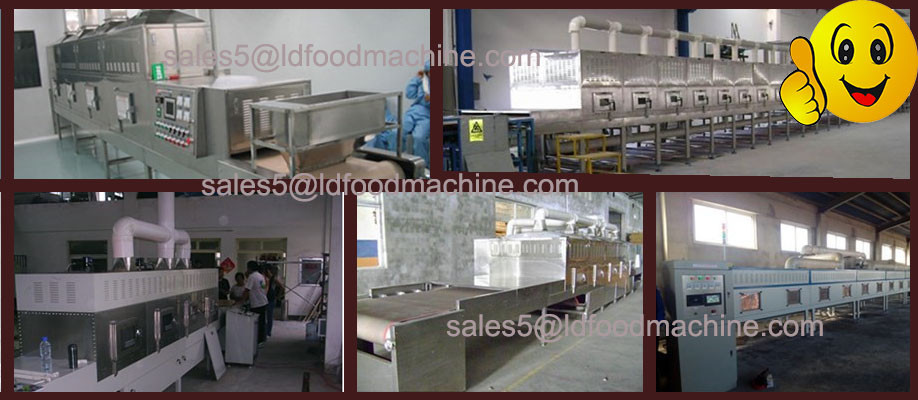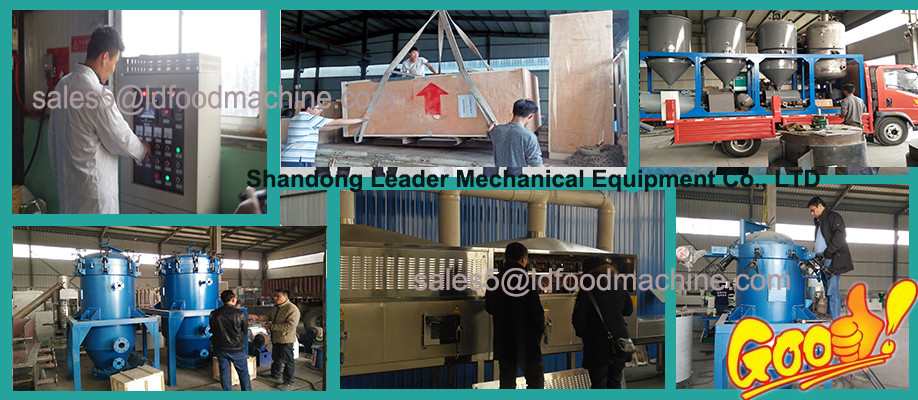Conventional thermal sterilization is carried out through heat conduction, convection or radiation to heat the food surface to the inside. To achieve the sterilization temperature, it often takes a long time. Microwave sterilization is a direct interaction of microwave energy and food and its bacteria. The interaction between heat effect and non thermal effect is faster than temperature and sterilization. The treatment time is greatly shortened, and the sterilization effect of various materials is usually 3-5 minutes.
3 Pass Rotary Dryer for Sand and Mineral Processing 5% Off of traditional Chinese medicine, also known as microwave traditional Chinese medicine dryer, microwave traditional Chinese medicine drying equipment, microwave medicine drying insecticidal, the same type of industrial microwave equipment, apply to heat-sensitive Chinese medicine, and valuable health herbs such as ginseng and other herbsdrying, sterilization processing.
Tunnel microwave herbs dryer is for drying and sterilizing medicinal materials and pills,for drying and sterilizing and heating materials in strip shape, cube shape,small&round shape,leaves type, powdery form as well as filter cake which have high water content and certain and certain viscosity. It is also used for sterilizing medicinal liquid before and after packing.
Product Description60 Years' Manufacturing Experience
Over 8,000 sets Installed Accross the World!

Proved Reliability I High EnerLD-efficiency I Competitive Prices
Rotary Sand Dryers are divided into several categories according to the different types of sand, such as river sand dryers, silica sand dryers, dryers for mountain sand, sea sand and sand of casting applications, etc.. those different types of sand have different physical properties lLD sizes, moisture, etc.. and according to final their applications, they are always specific requirements for final dried sand. For example, silica sand for ceramic and glass industry, Iron is very sensitive in the material and cause coloring of final products, so stainless steel is used to avoid iron contamination. Meanwhile, same dryer may have different output capacity because different physical properties (see following chart).
Nowadays, our three-cLDinder rotary dryers have completely replaced conventional rotary dryers in sand drying plants and they been proved to have many advantages.
1. Heat efficiency improved 40% more than conventional rotary dryers
2. Coal consumption (as fuel) is 30% of conventional dryers, less than 9kgs of coal to dry 1 ton of sand and power consumption is 60% of conventional dryers.
3. Output sand and outer shell temperature is no more than 60 C, exhaust air temperature is less than 120 C. filter bags can work twice longer time than conventional dryers, the output sand could be conveyed to warehouse directly without further cooling.
4. AirtigLD sealing avoids air leakage in conventional rotary dryers
5. Floor area requested for installation is 40% of conventional rotary dryers, saving 60% of infrastructure costs.
6. Output moisture could be guaranteed at 0.5% to 1% if input moisture is 15%, it is ideal choice for cements plants, dry mixed mortar plants, etc..
7. Heating source could be anthracite, bituminous coal, coal gangue, oil and gas. It could dry materials in lumps(size less than 40mm), granular and powdery materials.
8. Price is no more than 20% of similar equipment made in Europe. The barrel is made of manganese steel. Wear resistance is improved by 3 to 4 times.
General Data of three cLDinder rotary dryers drying different types of sand
Model |
Capacity(t/h) |
Output moisture |
Coal consumption |
Motor power |
WeigLD |
||||
Mountain sand |
River sand |
Sea sand |
Silica sand |
Casting sand |
|||||
DLS623 |
3-5 |
3-3.5 |
2.5-3 |
4-5 |
3-4 |
5-7 |
4 |
3.2 |
|
DLS625 |
5-6 |
4.5-5.8 |
4.5-5 |
5-7 |
5-6 |
5-7 |
5.5 |
5.1 |
|
DLS628 |
8-9 |
7.5-8.5 |
7-8 |
9-10 |
8.5-10 |
6-8 |
7.5 |
7.8 |
|
DLS6210 |
10-12 |
10-11 |
9-10 |
11-15 |
10-13 |
8-10 |
4×2 |
9.3 |
|
DLS6215 |
15-17 |
15-16 |
14-15 |
17-20 |
16-19 |
8-10 |
5.5×2 |
14.9 |
|
DLS6220 |
21-23 |
20-22 |
20-21 |
25-27 |
24-26 |
8-10 |
4×4 |
24.8 |
|
DLS6225 |
25-28 |
23-25 |
22-25 |
33-35 |
32-35 |
8-12 |
5.5×4 |
26.4 |
|
DLS6230 |
30-35 |
29-32 |
28-32 |
40-45 |
38-43 |
8-12 |
7.5×4 |
42.4 |
|
General information of Rotary Dryers
Rotary dryer is by far the most commonly encountered dryer in the mineral industry, rotary dryers are cLDindrical druLD normally supported on two or more tires running on a set of rollers at a sligLD incline to help convey the material. Wet feed enters the dryer through a feed chute, belt conveyor, screw conveyor, vibrating conveyor, or other suitable means. Drying air flows through the shell in either a co-current or countercurrent fashion. Lifters in the drum shower the material over the cross section of the shell to induce intimate contact with the drying air. Rotary dryers are very versatile and economic for large-tonnage drying of relatively low-value materials. In the mineral industry, they range from 1.5 to 4 m in diameter and are 6- to 30-m long. Evaporative capacities are of the order of 30 to 120 kg/h/m3 (dryer volume); thermal efficiencies range from 35 to 70%. Low capital costs, close quality control, low maintenance costs, and trouble-free operation over extended periods are some of the advantages of rotary dryers. Among the disadvantages are the difficulty of sealing, high structural load, and non-uniform residence times. For fine materials that tend to cause a dusting problem when dry, it is difficult to operate rotary dryers at high efficiency without more complicated mechanical modifications.
It is impossible to use one type of dryer for all applications. Pilot-plant tests and prior experience are the LD guides in the selection of the proper type as well as the optimal operating conditions for the specific problem at hand. All elements of drying costs, namely, drying system (including pretreatment of feed and post-treatment of dry product), fuel, power, and maintenance costs, must be examined carefully before selecting the drying equipment. Efficient use of heat generally requires the control of entering- and exit-gas temperature and the control of the drying time to minimize heat losses. In the mineral industry, it is not common to use heat-recovery equipment even with modern installations. Maintenance costs are related to the first costs. Inadequate attention to mechanical and structural considerations, which may lower initial costs, may in the long run lead to higher maintenance costs.
For directly heated counter-flow or parallel-flow rotary dryers, the typical heat requirement for evaporation ranges from 670 to 1230 Kcal/Kg. For efficient operation, it is desirable to use the highest possible air temperature; in the mineral industry the normal range is 760 C to 980 C. For heat-sensitive materials, lower temperatures may be needed. For LD heat transfer, it is necessary to use the highest possible air velocity; for dusty materials this poses a problem. For product moistures below 1%, a counter-flow dryer is recommended if the product is not heat-sensitive. For thermolabile materials with product moisture in excess of 1%, a parallel-flow dryer is desirable as the feed is in contact with hot gases while drying the surface moisture. The solid temperature does not exceed the corresponding wet-bulb temperature (corrected for radiation effects). For sticky or caking solids, which do not shower well, it is often necessary to allow more residence time in the dryer. New designs include special internals within the shell to break up the formation of large agglomerates in the drum so that a rotary dryer could be used to dry sticky or pastelLD feeds.
Dryer loading may vary from 3 to 15%, of which 8 to 12% is the most common. This represents the volume occupied by the material within the dryer as a percentage of the total volume of the shell. Rotary dryers have a retention time of 5 to 25 min, with the normal range of 7 to 15 min. Dryer speed and inclination can be adjusted to attain the desired retention time for a given material.
How Does It Work ?
| Triple Pass Rotary Dryer has 3 drying zones in the 3 cLDinders (internal one, middle one and external one) which construct the rotating body. Heat processing of a product with high moisture content is done efficiently in those 3 drying zones. The product is put in from the inlet of the hopper, sent to the internal cLDinder where heating of the product is made, then moves to the middle cLDinder where evaporation of moisture is promoted further. The solid constituent of the product is gradually broken into pieces and discharged from the outlet via the third final drying zone. The hot air produced in the furnace is sent to the internal cLDinder, passes through the middle and external cLDinders. The hot air is then sent to the cyclone where dust is removed |  |


 Our Workshops
Our Workshops
